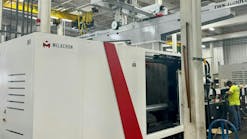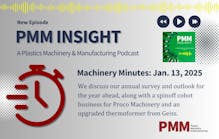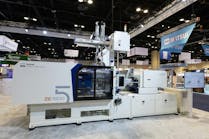Ensuring that a product meets all customer specifications prior to shipping is critical for any plastics manufacturer. To meet this need, equipment providers are developing innovative equipment and accessories to test finished parts and minimize human error.
The most recent testing machines from Instron, Norwood, Mass., are the TestMaster AT3 for tensile testing and AT3+ for tensile and flexibility testing, which offer many of the benefits of Instron's robotic AT6 systems in a smaller footprint. The automated specimen-loading feature means that there is no human handling during the process, said Lorenzo Majno, who is the automation manager of the Engineered Systems Group and director of the Global Composites Testing Group. To use the devices, a technician loads bar-coded samples into trays, then inserts a tray into the machine. By reading the bar code on each sample, the machine is able to run the proper test, which improves reliability.
The automation reduces the potential for human error and frees up operator time without the expense of robotics. "It takes, maybe, 10 minutes to put the samples in the tray. Then the operator can press the go button and walk away for about four hours," Majno said. "With automated specimen handling, you often have expensive robotic systems, but this is nonrobotic, so we were able to reduce the cost to about half that of robotics."
Suitable for a wide range of rigid, tensile, and flex materials, the system also can be manually loaded with virtually zero switch-over time between tests.
Tinius olsen TMc-united states
Harry Yohn, a product applications specialist at Tinius Olsen TMC-United States, Horsham, Pa., said post-production trials, such as impact testing, present unique challenges. The company's testing machines are built to conform to ASTM and ISO standards, but because each manufacturer's specifications are different, part testing often requires some creativity.
"It's a destructive test where they either have to mold a specific specimen for this test, or they have to cut a specimen out of a part," Yohn said. "The difficulty comes in how you hold it and how you get consistent results out of it."
Along with its IT 504 plastics impact tester, the company offers a variety of optional fixtures and weights. It also offers its ST line of electromechanical universal testing machines to test a wide range of materials and finished products for strength properties in tension, compression, flexure, shear and tear.
Shimadzu Scientific Instruments
Shimadzu Scientific Instruments, Columbia, Md., is seeing growing interest in video extensometers with thermal chambers and temperature-dependent testing, company spokesman Kevin McLaughlin said. Customers are also seeking accessories for testing to ASTM composite standards.
Within the last couple years, the company extended its AGS-X dual-column electromechanical universal tester lineup to include tabletop models with capacities of either 20 or 50 kilonewtons and floor models with capacities of either 100 or 300 kilonewtons. "Our AGS-X universal testers have faster data acquisition, up to 1 kilohertz, have comprehensive safety features, including one-touch stroke limiters, emergency-stop switches and optional safety covers," McLaughlin said. The AGS-X series can auto-tune control parameters in real time based on measured test force and strain data, allowing users to measure the stiffness of an elastic material "in the ultra-small strain domain according to ISO 527, ISO 178, and JIS K7171." The devices can be run as stand-alone units or with Shimadzu's Trapezium X universal testing software.
Carl Zeiss Industrial Metrology LLC
Carl Zeiss Industrial Metrology LLC, of Maple Grove, Minn., expanded its O-Inspect line last year, offering multiple system sizes, configurations and options.
O-Inspect machines combine four measuring machines — a profile projector, measuring machine, microscope and contour measuring machine — in one and have both optical and contact sensors to measure each characteristic of the part. They can be used for testing a wide range of parts — from vehicle parts to components for smartphones — and provide with optimum reproducibility precise data about form and position tolerances. This is of increased importance as plastics manufacturers strive to ensure their test labs deliver ever-higher levels of accuracy and reproducibility.
The machine's benefits include the option to select from several equipment/measuring range sizes, load capacities and contact probes — "all this with increased dynamics and the option of adding a chromatic focus sensor at any time," said product manager Christoph Stark. For small, delicate workpieces or large quantities, the camera sensor can be used. The contact sensor helps identify 3-D characteristics with accuracy compliant with ISO standards. Pairing the system with Zeiss Calypso software simplifies the detection of errors and the identification of their causes.
With the Vast XXT scanning sensor installed on the O-Inspect, true 3-D measurements are possible. The large ring light provides complete lateral illumination enabling the identification of the contrasts of 3-D characteristics. An optional white light distance sensor, available for O-Inspect 442, can be used to optically measure 3-D structures. O-Inspect allows scans with probing forces in the millinewton range in areas where other multisensor measuring machines permit only single-point measurements with relatively high probing forces.
"We are providing our customers with considerably more flexibility when they select the right system for their specific requirements," Stark said.
Lisa Jo Lupo, correspondent
Contact:
Carl Zeiss Industrial Metrology LLC, 800-327-9735, www.zeiss.com
Instron, 800-564-8378, www.instron.us
Shimadzu Scientific Instruments, 410-381-1227, www.ssi.shimadzu.com
Tinius Olsen TMC-United States, 215-675-7100, www.tiniusolsen.com








